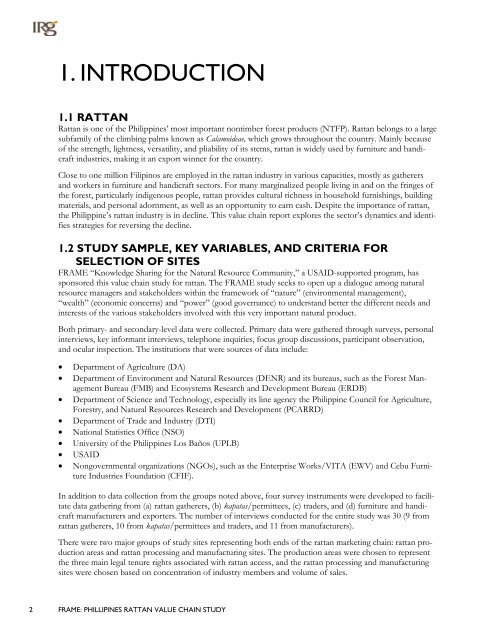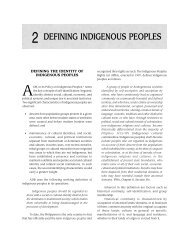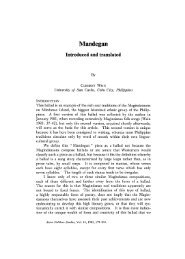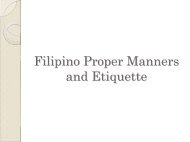PHILIPPINES RATTAN VALUE CHAIN STUDY - Aboutphilippines
PHILIPPINES RATTAN VALUE CHAIN STUDY - Aboutphilippines
PHILIPPINES RATTAN VALUE CHAIN STUDY - Aboutphilippines
You also want an ePaper? Increase the reach of your titles
YUMPU automatically turns print PDFs into web optimized ePapers that Google loves.
1. INTRODUCTION1.1 <strong>RATTAN</strong>Rattan is one of the Philippines’ most important nontimber forest products (NTFP). Rattan belongs to a largesubfamily of the climbing palms known as Calamoideae, which grows throughout the country. Mainly becauseof the strength, lightness, versatility, and pliability of its stems, rattan is widely used by furniture and handicraftindustries, making it an export winner for the country.Close to one million Filipinos are employed in the rattan industry in various capacities, mostly as gatherersand workers in furniture and handicraft sectors. For many marginalized people living in and on the fringes ofthe forest, particularly indigenous people, rattan provides cultural richness in household furnishings, buildingmaterials, and personal adornment, as well as an opportunity to earn cash. Despite the importance of rattan,the Philippine’s rattan industry is in decline. This value chain report explores the sector’s dynamics and identifiesstrategies for reversing the decline.1.2 <strong>STUDY</strong> SAMPLE, KEY VARIABLES, AND CRITERIA FORSELECTION OF SITESFRAME “Knowledge Sharing for the Natural Resource Community,” a USAID-supported program, hassponsored this value chain study for rattan. The FRAME study seeks to open up a dialogue among naturalresource managers and stakeholders within the framework of “nature” (environmental management),“wealth” (economic concerns) and “power” (good governance) to understand better the different needs andinterests of the various stakeholders involved with this very important natural product.Both primary- and secondary-level data were collected. Primary data were gathered through surveys, personalinterviews, key informant interviews, telephone inquiries, focus group discussions, participant observation,and ocular inspection. The institutions that were sources of data include:• Department of Agriculture (DA)• Department of Environment and Natural Resources (DENR) and its bureaus, such as the Forest ManagementBureau (FMB) and Ecosystems Research and Development Bureau (ERDB)• Department of Science and Technology, especially its line agency the Philippine Council for Agriculture,Forestry, and Natural Resources Research and Development (PCARRD)• Department of Trade and Industry (DTI)• National Statistics Office (NSO)• University of the Philippines Los Baños (UPLB)• USAID• Nongovernmental organizations (NGOs), such as the Enterprise Works/VITA (EWV) and Cebu FurnitureIndustries Foundation (CFIF).In addition to data collection from the groups noted above, four survey instruments were developed to facilitatedata gathering from (a) rattan gatherers, (b) kapatas/permittees, (c) traders, and (d) furniture and handicraftmanufacturers and exporters. The number of interviews conducted for the entire study was 30 (9 fromrattan gatherers, 10 from kapatas/permittees and traders, and 11 from manufacturers).There were two major groups of study sites representing both ends of the rattan marketing chain: rattan productionareas and rattan processing and manufacturing sites. The production areas were chosen to representthe three main legal tenure rights associated with rattan access, and the rattan processing and manufacturingsites were chosen based on concentration of industry members and volume of sales.2 FRAME: PHILLIPINES <strong>RATTAN</strong> <strong>VALUE</strong> <strong>CHAIN</strong> <strong>STUDY</strong>
















